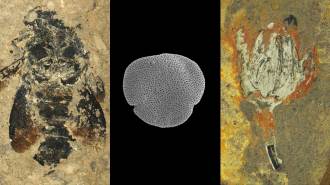- More than 2 years ago
Imagine discovering a mammal without mammary glands or an insect with eight legs. Aquatic herbs in the genus Hydatella pose a similar paradox—they lack a defining developmental feature of flowering plants, raising questions about their evolution and rampant speciation during the past 135 million years.

Evolutionary biologists group together organisms that share unique traits, such as mammary glands or fur, which presumably emerged in a common ancestor. In the flowering plants—the angiosperms—these features include bearing true flowers and key events that occur during fertilization and development.
One such event is double fertilization. The plants’ pollen grain yields two sperm cells each containing genetic material. One partakes in normal fertilization by joining with the egg cell to make an embryo. The other sperm fuses with two of mom’s nuclei to make a starchy tissue called endosperm that, like a placenta, nourishes the developing plant. This second fertilization and its timing are hallmarks of angiosperm evolution. “These are the great rules of flowering plants,” says botanist William Friedman of the University of Colorado at Boulder, whose new study of Hydatella was published online March 19 in Nature.
Friedman’s analysis finds that Hydatella doesn’t make proper endosperm—it provides nutritive tissue made only from mom’s cells. And this starchy plant food starts developing before fertilization has even taken place.
“This is very unusual—putting down a payment irrespective of whether there is an embryo to invest in,” says Friedman. The strategy is unusual for any creature but unheard of in flowering plants.
Yet, a number of detailed studies of molecules, genes, and cells of angiosperms reveal that the usual traits don’t necessarily hold true at the base of the flowering-plant family tree. Plants in one of the oldest surviving floral lineages, the water lily group known as the Nymphaeales, make endosperm, but mom contributes one nucleus, not two. Last year, an analysis revealed that members of the Hydatellaceae—a family that includes diminutive, grasslike water plants such as Hydatella—were not, in fact, highly evolved grasses, but were the Nymphaeales’ closest relatives.
The standard operating procedure of angiosperms is to delay additional maternal investment in seeds until after fertilization, which prevents wasting of precious resources, says Sarah Mathews of Harvard University’s Arnold Arboretum. This isn’t the first odd feature found in the more ancient lineages, suggesting that the angiosperms took a while to figure out their branding strategy. Once they got going, however, they became hugely successful—today the flowering plants occur as 300,000 species and occupy every continent.
Whether making endosperm at all, and then only after fertilization, contributed to the flowering plants’ astounding diversity is an open question, Mathews says. But, she says, Hydatella does provide a window to the past, “a picture into the variety of different experiments being tried at this stage of the game.”






